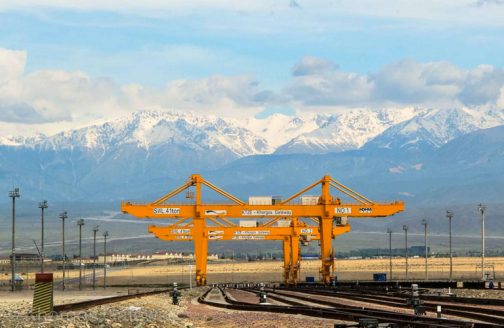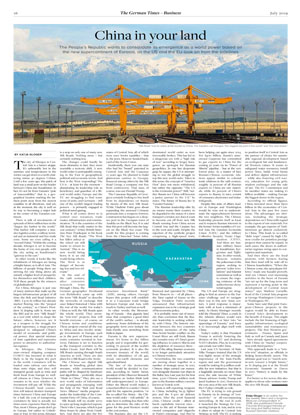China wants to consolidate its emergence as a world power based on the new supercontinent of Eurasia, as the US and the EU look on from the sidelines

The city of Khorgos in Central Asia is a barren steppe. It’s unbearably hot in the summer, and temperatures in the winter can get down to a teeth-chattering minus 40 degrees Celsius. Until a few years ago, this patch of land was a small post on the border between China and Kazakhstan. In fact, it’s not far from Eurasia’s “pole of inaccessibility,” that is, a geographical location marking the farthest point away from the nearest coastline in all directions. And yet, at the moment, the city is well on its way to becoming a major hub at the center of the Eurasian continent.
There is talk of investments of upwards of $600 million here in the “largest dry harbor in the world.” This harbor will comprise a massive logistics center, a railway terminal and an industrial and free-trade zone. Some are even calling it a “second Dubai.” Within the coming decade, Khorgos is set to become the home of 100, 000 people, with the city acting as Kazakhstan’s “gateway to the east.”
In other words, it looks like the inhabitants of Khorgos are facing a bright future, as is all of Asia. The billions of people living there are striving for one thing above all, namely a higher level of prosperity for themselves and their children. Will these people be the winners of globalization? For China, Khorgos is just one of many stations that make up the largest infrastructure project of all time: the Belt and Road Initiative (BRI). Up to $1 trillion has already started flowing into the “project of the century,” as China’s President Xi Jinping calls it. Some see the BRI and its new “Silk Roads” as a tool with which to shape the future; others, however, see it as a weapon in the struggle for global supremacy, a mega-project designed to safeguard China’s model of economic and political power, that special mixture of state capitalism and repressive power so attractive to authoritarian regimes.
In Khorgos, the Chinese state-owned shipping company COSCO has invested in what is likely to be the largest dry port in the world. Containers will be loaded onto railway cars rather than onto ships, and they will transport goods such as wine and fresh food from Europe to well-off citizens in China. However, it remains to be seen whether the investment will pay off. While the Chinese-Kazakh land connection will indeed shorten transport times between China and Europe by a half, the cost of transporting containers by land is actually ten times more expensive than by ship. Plus, most Chinese goods don’t go to Europe, but rather to Uzbekistan or Iran. In this sense, Khorgos is a stop on only one of many new Silk Roads. Nothing more – but certainly nothing less.
The changes could hardly be more dramatic; in fact, they more resemble a tectonic shift. A new world order is unstoppably emerging in the East in geographical, political and economic terms. And how is the West responding? The US is – at least for the moment – abandoning its leadership role as beneficiary and guardian of a liberal world order; Europe and the EU are struggling to find some sense of unity; and Germany – still one of the world’s largest trading powers – is primarily engaged in political navel-gazing.
What it all comes down to is control over resources, trade routes, infrastructure and communication. “It is the countries of the Silk Road that really matter in the 21st century,” writes British historian Peter Frankopan in his book The New Silk Roads: “The West has fallen asleep at the wheel yet still wants to return to ‘normal.’ This is no new world being born; it is an old world being reborn. The West is in danger of becoming less and less relevant.”
At the end of the 19th century, after extensive research trips through China, the German geographer Ferdinand von Richthofen came up with the term “Silk Roads” to describe the networks of exchange that once linked historical China with the rest of the world. For today’s China as well, the Silk Roads span the whole world. They promise “win-win” projects that will benefit everyone – of course, on Chinese terms and conditions. These projects extend all the way to Africa and also involve strategic investments in Europe, such as in the port of Piraeus and an entire container terminal in Antwerp. Pakistan is set to function as the transport corridor to the Indian Ocean. And there will be Silk Roads running through South America as well. There are also plans for a Silk Road in the Arctic.
The Chinese see digital Silk Roads as bundling global data streams, while communication paths will be shaped by hardware and algorithms – preferably those “Made in China.” They also see a new world order of information and propaganda emerging with the help of the “Belt and Road News Alliance” media program – under the leadership of the Communist Party of China, of course. Silk Roads will no doubt serve to open up long-neglected regions.
There’s the Caucasus, which is just three hours by plane from Frankfurt. And there are also the five states of Central Asia, all of which were once Soviet republics – that is, the poor, Moscow-funded backyard of the Soviet Union.
Incidentally, there was one man who had his “brand” patented in Central Asia and the Caucasus 12 years ago. He planned to build glamorous casinos in Georgia, financed among others by the Silk Road Group, a company not free from controversy. That man, of course, was one Donald Trump.
The Caucasus Republic of Georgia is certainly looking to free itself from its dependence on Russia by means of the new Silk Road. While Vladimir Putin goes about expanding the annexed Crimean peninsula into a weapons fortress, construction has begun on a deep-sea port in the Georgian town of Anaklia on the Black Sea. It is said that this port will become the largest on the Black Sea coast. The credit for this project is coming from the China-led “Asian Infrastructure Investment Bank” (AIIB), among others. Georgia hopes this project will establish it as a Caucasian trade bridge between Europe and Asia, with reach to Turkey and Iran as well.
In other words, the blossoming of Eurasia – that gigantic land mass that comprises a good third of the earth’s surface – is already underway. Some definitions of the geographic term even include the Indo-Pacific area stretching from India to Japan.
Eurasia is the new supercontinent. It’s home to five billion people and is responsible for generating 70 percent of the world’s economic product. It is also the resource treasury of the world, with its abundance of oil, gas, wood, rare-earth elements and agricultural land.
The fate of the democratic world would be decided in Eurasia, according to Samir Saran, president of the Observer Research Foundation, an Indian think tank still underappreciated in Europe. Either the liberal world makes a concerted effort to counter China’s grab for the supreme position, “or the so-called Pax Sinica – the Chinese world order – will unfold.” At stake here is nothing less than who gets to determine the rules of the game for the post-Western world in the 21st century. The Russians also see the US-dominated world order as now irrevocably broken. This has led to a dangerous era with a “high risk of war,” according to Sergey Karaganov, an apologist for Russian geopolitics. In one last desperate gasp, he argues, the US is attempting to win the global struggle to top this new world order. Taken in this sense, the concept of “America First” does not mean withdrawal, but rather the opposite: “The US is the revisionist power!” Still, “neither Russia nor China will become a junior partner to the US,” he notes. The future of Russia lies in “Greater Eurasia.”
The Russian leadership elite by no means wants their country to be degraded to the status of a mere transport corridor, nor does it want to become cut off from new Silk Roads running from China across Central Asia and the Caspian Sea to the west and south. Despite the rejection of the symbolic project comprising a high-speed train, financed and operated by China, from Moscow to – of all places – the Tatar capital of Kazan on the Volga, President Putin recently announced that infrastructure expansion was to be a strategic goal of his economic policy.
It is probably more out of necessity than conviction that the Russian leadership is seeking solidarity with China. The historic mistrust between the two countries remains; memories of the 1969 Sino-Soviet border conflict on the Ussuri River are still fresh. Russia also remains wary of China’s growing influence in eastern Siberia and the depletion of resources there – even if the ailing Russian economy is no longer particularly attractive to Chinese workers.
Nevertheless, the two countries are moving closer together in a number of strategic areas. In 2017, Chinese ships carried out maneuvers alongside Russian war ships in the Baltic Sea. Last year, for the first time, 3,200 Chinese soldiers took part in the Russian military exercise known as Vostok 2018.
Russia is still exporting weapons to China, including Su-35 fighter jets and the S-400 air defense system. After the 2008 financial crisis, Chinese credit – albeit at harsh capitalistic interest rates – came to the aid of Russian state-owned companies and oligarchs in Putin’s entourage. And they’ve been helping out again since 2014. For $400 billion, Russia’s state-owned Gazprom has committed to gas exports to China for the coming 30 years via its “Power of Siberia” pipeline – but at the very lowest price. As a matter of fact, Russian-Chinese economic relations appear similar to colonial trade relations in the 19th century: roughly 75 percent of all Russian exports to China are raw materials, while 80 percent of China’s exports to Russia, in turn, consist of consumer, electronics and industrial goods.
Despite this state of affairs, leaders in Europe and Washington would be wise not to underestimate the rapprochement between the two neighbors. The Chinese leadership presents itself as loyal, and it respects Russian interests in the former Soviet republics of Central Asia, the Eurasian Economic Union (EAEU) and the military Collective Security Treaty Organization (CSTO). And there are Russian military bases in Kazakhstan, Kyrgyzstan and Tajikistan. In other words, Moscow remains the policeman of the region, seeking to prevent “color revolutions” and Islamist extremism as well as to ensure the ongoing existence of the authoritarian-dictatorial regime.
The US and Europe are struggling to find an answer to the Eurasian challenge and to navigate their way in this new Asian century. A joint response is important, with at least a minimum of unity. As Henry Kissinger recently told the Financial Times, a crack in the Atlantic alliance would turn Europe sooner or later into “an appendage of Eurasia,” and force it to increasingly align itself with China.
Today’s reality is that President Trump is actively fostering the division of the EU and declaring NATO obsolete. Plus, he is carrying out a trade war with China.
Last year, US Secretary of State Mike Pompeo insisted that the US was highly aware of the strategic importance of the Indo-Pacific region and said the government would be making $113 million available for new initiatives. But that is a laughable amount, no more than even the side income of White House advisors Ivanka Trump and Jared Kushner in 2017. However, in the core area of the new Silk Roads, the US plays virtually no role.
The EU is trying to win ground in Eurasia via its strategy of “connectivity” or all-encompassing networking. At the end of 2018, it launched the Strategy for Connecting Europe & Asia, and in 2019 it plans to adopt its Central Asia Strategy as well. The EU is seeking to position itself in Central Asia as the partner of choice for sustainable regional development based on ecological, fair and fundamental Western values. It wants to safeguard water resources, install power lines, build wind farms and deliver digital infrastructure – while also fostering civil society, education for young girls, student exchanges and the rule of law. The EU Commission and its member states are making €1 billion available – making Europe the biggest donor in the region.
According to official figures, China invested more than $300 billion in the economies of Central Asia in the past five years alone. The advantages are obvious, including the strategic dependence on China with regard to the export of raw materials. For example, the gas exports of Turkmenistan go almost exclusively to China. This leads to so-called “debt traps” caused by high Chinese credits for pointless prestige projects that cannot be repaid. In such cases, the doors in authoritarian regimes swing open to corruption and nepotism.
And then there are the local protests, with farmers fearing that their land will be sold off to Chinese leaseholders. “When the Chinese come, the apocalypse follows,” reads one Kazakh proverb. And yet, China’s ever-increasing activities in the heart of Eurasia “are set up for the long term and represent a turning point in the development of Central Asian states,” says Marlene Laruelle, head of the Central Asia program at George Washington University in Washington, DC.
Some have said that joint European- Chinese projects in the region would be able to foster Central Asia’s development to the benefit of Europe. This might include the fair financing of high-quality infrastructure, ecological sustainability and transparency projects. The first Western governments – France, Spain and Italy as well as Canada and Japan – have already signed agreements with China on “market cooperation with third parties.”
This approach leads to a “winwin- win” situation, as officials in Beijing benevolently assert. The ultimate goal was to “march armin- arm toward a bright future,” as Xi Jinping put it at the World Economic Summit in Davos in 2017, “history is made by the brave.”
For better or for worse, this also applies to those who venture onto the new Silk Roads.
Katja Gloger
is a writer for the weekly Der Stern. She has been based as political correspondent in Washington, D.C.




